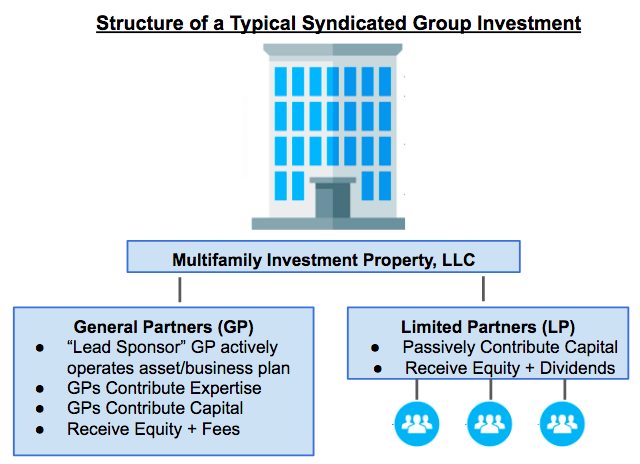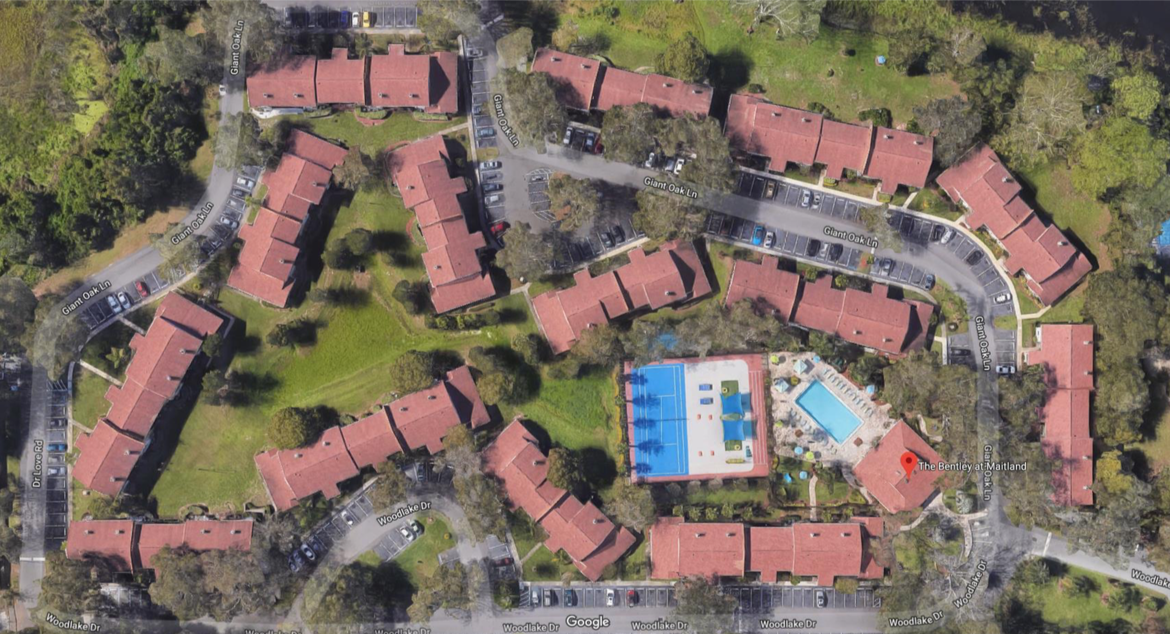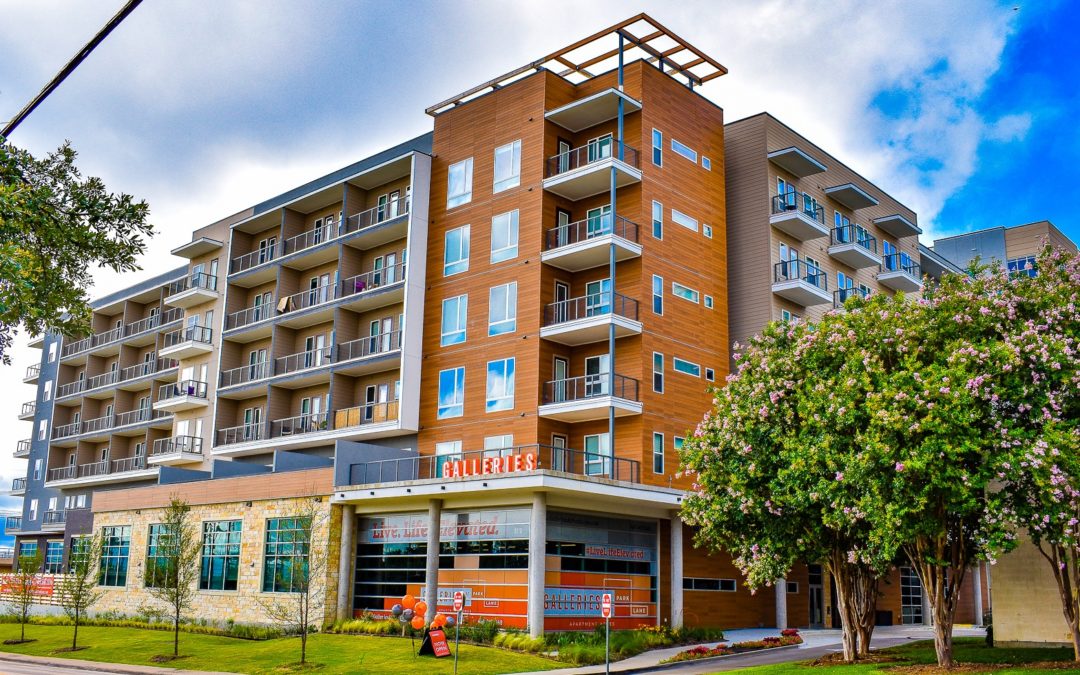Introducing The Best-Kept Secret In Investing:
Real Estate Syndications
For decades, syndications were an investment strategy reserved for the ultra-wealthy and well-connected. Today, they are accessible to the savvy, in-the-know investor. Now the rest of us can utilize this investment strategy to grow wealth and generate financial freedom in our lives.
In this article we provide a foundation of information and knowledge about passively investing in real estate syndications so that you can feel comfortable reviewing and investing in them.
So, grab a seat and let’s break it all down

.
What is Passive Investing in Syndications?
Simply put, syndication is an effective way for a group of real estate investors to pool their financial resources and business expertise to purchase much larger multifamily apartment buildings than they would be able to acquire and manage on their own. They then share in the ownership and financial success of the investment.
Basically, we buy apartment buildings together. You passively invest a minimum of $50K with other fellow investors and our team manages the business plan. We then both enjoy the rental income that our residents pay monthly, as well the profits when the building is sold a few years down the line.
The 6 Key Benefits of Passive Investing in Syndications
1. It’s Passive: No Time Requirement – You simply invest a minimum of $50K, and then sit back and watch it grow. Experienced teams of operators, like Akras Capital, have vetted the investment and put the systems and local teams in place to ensure its success. There is no need for the passive investor to put time or energy into the project, making it easier to invest if you have a full time job or a family to care for.
2. Experienced Management Teams – The General Partners (defined below) perform the strictest due diligence on these types of deals. This includes gaining deep market knowledge, understanding risk parameters and developing return assumptions, and then communicating them transparently to potential investors. They do all the work, allowing you to invest long distance and without needing experience of your own to operate a business plan. This allows you to enjoy the returns, but focus on what matters most in your life.
3. Returns – Syndicated deals offer higher returns than a lot of other investments and can provide a great way to diversify your portfolio away from the stock market. Depending on the deal, returns can range from an annualized 14-17%.*
4. Cash Flow – These deals provide monthly/quarterly cash flow which go directly into your bank account as cash – not many other investments provide these types of dividends.
5. Diversification – These deals help diversify your investment portfolio and will provide you added protection in a downturn, as people still need places to live and renting becomes even more popular in a recessionary environment. Unlike stocks, which can lose all value and disappear into cyberspace, these investments are collateralized, with a hard asset at the foundation of the investment.
6. Tax Advantages – These deals can provide significant tax advantages for investors (we recommend you ask your CPA and read our article HERE)
*Past performance is no guarantee of future results. Market conditions change, as do return profiles for investments. Please note: This material does not constitute an offer to sell nor is it a solicitation of an offer to buy securities.

The Basics: Who’s Involved In A Syndication and Where Do You Fit In?
In a syndicated deal there are two parties involved: the General Partners (GPs), led by the “Lead Sponsor”, and the Limited Partners (LPs), which can be a small group of independent investors up to several hundred.
The GPs, headed by the Lead Sponsor, are responsible for finding the investment property, getting it under contract, putting the business plan together, raising the funds to buy it, managing the day-to-day operations and ensuring the business plan is carried out and creating the targeted returns – basically all of the heavy lifting. They receive equity (ownership) in the property, as well as fees that cover their costs and compensate them. They will receive a share of profits commensurate with their equity when the property is sold.
The LPs are the investors who passively invest and provide most of the money to finance the purchase and remodel of the property. They do this in exchange for equity in that property and usually a monthly or quarterly cash dividend, based on revenue generated. They will also receive a share of profits commensurate with their equity when the property is sold.

Typical Syndication Properties and Deal Structures
Type of Property Acquired: Most properties that are typically syndicated, and the type Akras acquires, are large residential “multifamily” rental properties, commonly known as apartment buildings/complexes. They have many buildings housing apartments with a range of floor plans, from studios to 3 bedroom townhouses.
We acquire these properties in markets that meet strict data-driven criteria. These cities have large and growing populations, are inland (not on coasts) and have diverse and growing economies with anchors like Fortune 500 companies, universities and manufacturing.
The buildings are typically “Class B”, meaning they are comfortable and nice, but not necessarily luxurious. This makes them economical and attractive to the largest group of potential tenants. They are in “Class B” locations as well, meaning they are in nice, safe, well-located neighborhoods that tenants are proud to live in.
Finally, the properties we acquire are known as “value-add”, meaning they have some opportunity for being improved, whether that means remodeling the unit interiors, fixing up the exteriors, putting better management teams in place or adding new amenities to increase quality of life and attractiveness to tenants.
All of these characteristics ensure that the property has “forceable appreciation”, and the value of the property can be increased, irrespective of market conditions. Further, these properties have many buffers against economic downturn, helping to preserve investor capital.
Size of Property: The multifamilies that are typically syndicated range in size from 100-500+ apartment units. They often occupy several acres of land, and might also have amenities like pools, clubhouses and gyms. They often have on-site leasing and management offices, and several full-time staff who care for the residents and property.
Price: Typically, properties that are syndicated cost at least $5 Million and range up to $75M. They would have a mortgage of greater than $1M and therefore have higher costs associated with legal, accounting, and tax services. We usually need to raise 20% of the purchase price plus additional capital for fixing up and remodeling the property, allowing us to force appreciation and a higher value.
Structure of Deal: A best practice being used in these deals is the GP owns 30-40% of the equity in the property and the remaining 60-70% is split amongst the LPs, commensurate with the size of their investment.
Timeline: These deals are typically longer term holds, with an investment timeline of 5 years, so that the sponsors have time to effectively implement their business plan and forced appreciation on the property and sell it.

Real World Syndication Example: 200 Unit in Dallas, TX
A 200-unit apartment complex is found in the growing market of Dallas, Texas with a purchase price of $25 Million. The property is located in a great neighborhood close to employers, universities and entertainment. Due to its prime location and the quality of the property, it has a number of amenities such as a pool, clubhouse, gym, and mail room as well as an on-site management team and leasing office. However, 50% of the apartments are old and need to be remodeled/updated to market standard and rents are low relative to similar properties nearby, reflecting this lower unit quality. On top of that, the existing property managers are running the property inefficiently and incurring high operating costs.

The property is discovered and put under contract by the Lead Sponsor on the GP team who develops a business plan based upon solid past experience with similar properties. This plan includes hiring a best-in-class property manager, remodeling the units, appropriately raising rents, offering new services/amenities, and decreasing expenses. This plan increases revenue of the property, decreases costs and forces appreciation. It greatly increases the value of the property.
This plan is conservatively built and shows attractive returns to investors and sets the property up for future acquisition by another investment team. The GP team works to find passive LP investors who are interested in earning higher returns on their money and who are interested in passively investing in real estate. The GP’s raise a total of $7 Million between their own co-investment and the 30 LP passive investors who participate with $50K investments. This amounts to 20% of the price of the property plus an additional $2M for remodeling. This allows for the purchase of the property.
After the apartment complex is bought, the business plan is executed over a 5-year time period, providing monthly cash flow for the investors and eventually the property is sold at a higher value, the profits of which are distributed to the GPs and LPs commensurate with their investment, benefitting all.

How Investors Are Paid and How Much They Can Make
One of the most compelling aspects of passively investing in syndications is how investors are paid. Investors make money from both the rental income (cash flow) the property produces throughout the duration of the investment, as well as from the upside profit made when property is sold at a higher value at the end. Investors have been able to expect 13-17% average annual return in recent deals*. Here are some details related to these two types of returns the the investors receive:
Preferred Returns
Preferred returns (”Pref”) are cash dividends paid for the duration of the syndication project based upon the rental revenue that the multifamily apartment property generates from its tenants. It is typically between 6-9% annually, and is paid to the Limited Partner (LP) investors before any money is paid to the General Partners (GP). Most deals would distribute this cash to investors on a monthly or quarterly basis directly into their bank accounts.*
Basic Example: If an investor joins a syndicated deal as a passive LP, investing $100K and the preferred return is 8%, then she would receive $667 per month in their bank account ($8,000/12), which would amount to a total of $40K by the end of the 5 year project (the typical length of a syndicated deal).
*While preferred returns are commonly paid monthly or quarterly, this is not guaranteed. If the project requires additional reserves, or is not performing well, the GPs reserve the right to withhold the preferred distribution. In this case, it will accrue, and be paid out at a later period or when the property is sold.
Equity Splits and Profit From Sale
In a syndication, the GP and the LP own the property together. The common structure used to share this ownership is a “70/30 split. In this case, the LPs get 70% of the total equity (ownership) of the property for bringing the money, while the GP gets 30% of the equity for finding the deal and executing the business plan.
In most real estate syndications, the goal is to ultimately sell the investment property at the end of the project its new, higher valuation. At that time, the profits from sale are then split amongst the GPs and LPs based upon the equity split. At this point, the investor is paid based on what they own.
Basic Example: At the end of the business plan, the property is sold and the profit from the sale is approximately $5 Million. Of that profit, 70% or $3.5 Million, would be distributed amongst the LP investors based upon the amount of their original investment. The other 30% goes to the GPs. This is where the majority of an investor’s projected return comes from.
*Past performance is no guarantee of future results. Market conditions change, as do return profiles for investments. Please note: This material does not constitute an offer to sell nor is it a solicitation of an offer to buy any securities.

Interested In Investing Or Want To Learn More?
Akras Capital is a GP in select syndicated deals each year and we invite like-minded investors to join us. If you’d like to explore investing, or have questions, let’s start a conversation.
You can get started today by clicking the button below.
Here you can sign up for the Akras Insider, our monthly newsletter, easily connect with our team, and when ready, submit a simple investor application. Thanks, and we look forward to connecting with you!

